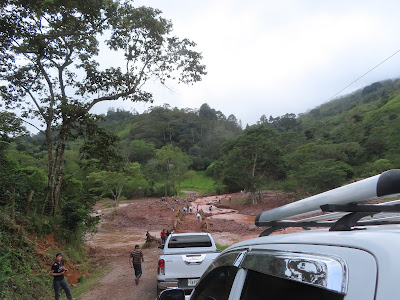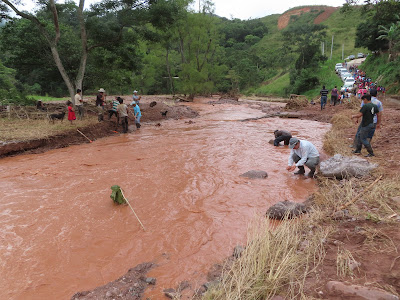It feels as if it’s been raining here for over two months. Looking at weather.com, I find that it has been raining consistently for just the last two weeks.
But, before that, there have been major downpours at least since the vigil of Pentecost, June 4. As the procession began, the heavens opened and most everyone was soaked as they walked several kilometers in procession from Concepción to Dulce Nombre.
In addition, the temperatures have been in the eighties since June, unusually hot for our area.
There has been a lot of damage from the rains, which are heavy and last for hours, often during the night.
The earth is saturated, and the streams and rivers are high.
In June, a rainstorm left a major sinkhole in the road leading into Dulce Nombre from most of the villages in the parish, near the aldea de Caleras.
But there has been even more extensive damages to the infrastructure.
Because of the rains, part of the ramp up to the bridge by El Limón has washed away two times. The first time abut July 24.
It was “repaired.” But when I had to go to El Limón on August 16, I found it washed away again.
But the damage downstream was worse. Half of a road had collapsed and major damage was done to a bridge; several fields were swept away.
These left several communities isolated, with no access by vehicles or busses, except for motorcycles.
About a week before the first collapse, I had scheduled a visit to San José Obrero, on July 17. I was warned to watch out for a problem. I proceeded in and took what was the former turn off and, if I hadn’t been alert, I would have gone off a ten foot cliff, where the road had collapsed a few days before.
I reversed the car and took the other path, which led through a stream bed.
The people told me that they had gone out and prepared the path by themselves – no help from the municipality.
Just a few days ago, in another part of the parish, the ramp to another bridge was washed out. This bridge connected several villages with the highway to La Entrada. Here are some photos from Facebook, the first two from the page of the mayor of Concepción.
Heavy rains washed away the ramp and several villages are isolated (though there is a long way to go around to get to the paved highway).
This bridge was recently rebuilt and the area around the bridge (which had been flooded during the Eta and Iota hurricanes of 2020) was rebuilt.
 |
| Photos from 2020 |
There was a major project to reconstruct the bridge with some other projects which, according to a sign at the site, cost 6,867,571.53 lempiras (about 279,000 dollars).
But a few years before that, the bridge had been replaced. Yet with the rains, it collapsed, revealing that the builders had taken short cuts and there was a part of the bridge where there were no reinforcement rebars. Ineptitude, shoddy work, short cuts to cut costs (for the construction firm), and corruption.
There are other problems. There have been a few landslides and there are several places where the threat of more landslides is great.
I personally had a problem with my sewage lines. After heavy machinery went down the road blow my house and smashed the underground sewer lines, a landslide detached the sewage lines (one for solid waste, the smaller one for liquid waste.
I was fortunate to have a plumber and three guys fix it in two days.
This is not just in our area.
The paved road that goes from La Entrada to Copán Ruinas has suffered extensive damage in two or three places.
When I went to Santa Rita for the installation of the new pastor of the parish, on September 27, I had to pass a place near El Jaral where half the road collapsed into the river and traffic is reduced to one lane.
A friend posted on WhatsApp a photo of the road near Nueva Esperanza in the municipality of San Jeronimo where the highway has deteriorated significantly.
My major concern now is that we have not yet begun the hurricane season, which usually is in October and November.
With the ground so saturated, with the roads in horrible conditions, with the river banks eroding, what will happen if we get the rains like we had in November 2020, with hurricanes Eta and Iota? I fear major disasters.
Last year I led a number of workshops in the parish to help people organize to monitor the situation and to be ready for disasters. I’ll be doing two more in October.
My hope is that the people will be organized, will monitor the situation, will be ready to response if there is a major threat, and so avoid loss of life, while at the same time avoiding panic.
It is really important that the people are organized to respond in their communities.
There is a great temptation is look to the political authorities (as well as non-governmental organizations) to provide the solution. In my opinion, this can lead to situations where the politicians manipulate the aid, especially here where corruption has been rampant and many politicians use aid to garner support.
And so we continue to struggle – in the face of the effects of climate change, the ongoing vestiges of corruption and ineptitude, and the ongoing impoverishment of our people.
May God accompany us in our struggles.


























No comments:
Post a Comment